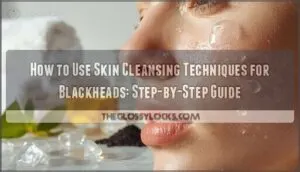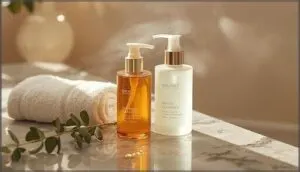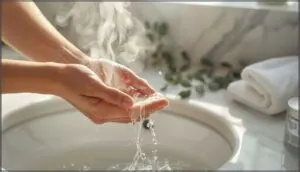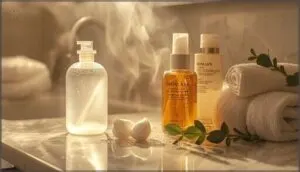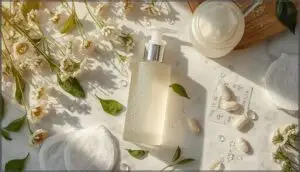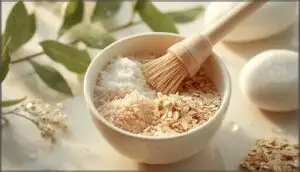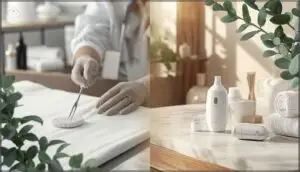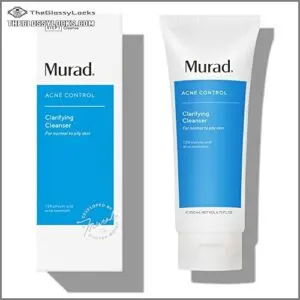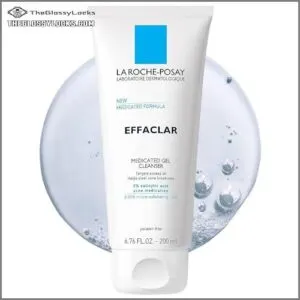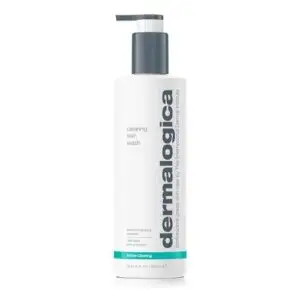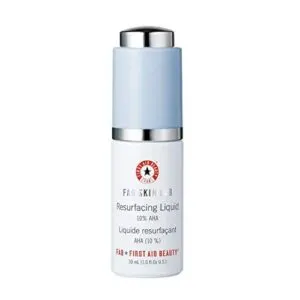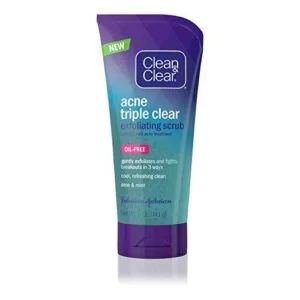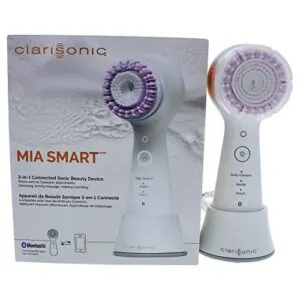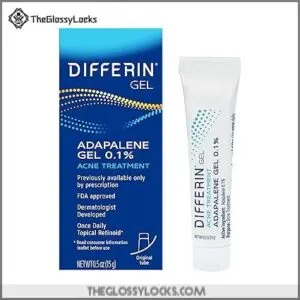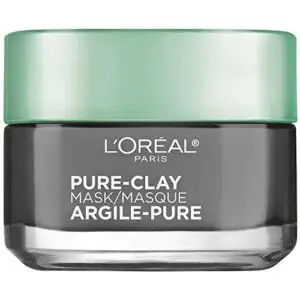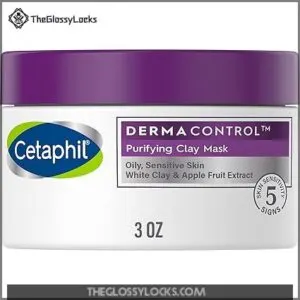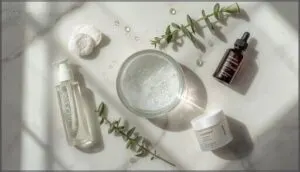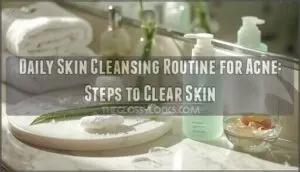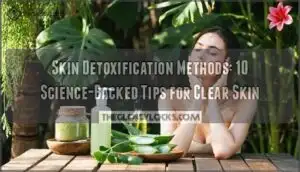This site is supported by our readers. We may earn a commission, at no cost to you, if you purchase through links.
Your skin produces sebum continuously, and when dead cells don’t shed properly, they mix with this oil to form plugs that oxidize into blackheads. Despite what many people believe, scrubbing harder won’t solve the problem—in fact, aggressive cleansing often triggers more oil production, creating a frustrating cycle.
The solution lies in understanding how pores actually function and using targeted cleansing techniques that work with your skin’s natural processes rather than against them. Double cleansing removes up to 85% of sebum-based impurities, while specific ingredients like salicylic acid penetrate oil-filled pores to dissolve blockages from within.
When you combine proper cleansing methods with strategic exfoliation, you address both the surface buildup and the deeper congestion that keeps blackheads returning.
Table Of Contents
- Key Takeaways
- What Causes Blackheads and How to Prevent Them
- Effective Skin Cleansing Techniques for Blackheads
- Exfoliation Methods to Unclog Pores
- Professional and At-Home Blackhead Removal
- Top 10 Products for Blackhead Removal
- 1. Murad Clarifying Acne Control Face Wash
- 2. La Roche-Posay Acne Face Wash
- 3. Dermalogica Clearing Skin Acne Face Wash
- 4. First Aid Beauty AHA Resurfacing Liquid
- 5. Clean Clear Acne Exfoliating Face Scrub
- 6. Clarisonic Mia Smart Facial Cleansing Brush
- 7. Silicone Face Cleanser and Massager
- 8. Differin Acne Treatment Gel Retinoid
- 9. L’Oreal Paris Pure Clay Mask
- 10. Cetaphil DermaControl Purifying Clay Face Mask
- Building a Blackhead-Fighting Skincare Routine
- Frequently Asked Questions (FAQs)
- Conclusion
Key Takeaways
- Blackheads form when excess sebum mixes with dead skin cells in your pores and oxidizes upon air exposure, and aggressive scrubbing actually triggers more oil production rather than solving the problem.
- Double cleansing removes up to 85% of sebum-based impurities while salicylic acid penetrates oil-filled pores to dissolve blockages from within, making this combination significantly more effective than harsh scrubbing alone.
- Chemical exfoliation with salicylic acid (0.5-2%) or AHAs (5-10%) penetrates deeper than physical scrubs and shows over 60% blackhead improvement after several weeks when used 1-3 times weekly based on your skin’s tolerance.
- Professional treatments like comedone extraction and chemical peels deliver measurable results when over-the-counter products fail after 6-8 weeks, with dermatologist-performed extractions reducing infection risks to below 1%.
What Causes Blackheads and How to Prevent Them
Blackheads can be stubborn, but understanding what causes them makes prevention much easier. Your skin’s habits and daily choices play a big role in how often they show up.
Let’s look at the main reasons blackheads form and the steps you can take to keep them at bay.
How Blackheads Form in Pores
When your skin’s sebum production ramps up, dead cells mix in and block the follicle, setting the stage for blackheads. The pore structure lets air in, triggering an oxidation process that darkens the plug.
While bacteria play a role in irritation, it’s the clogged pores—packed with sebum and debris—that are the root causes of blackheads. Blackheads are also known as open comedones.
Common Triggers and Risk Factors
You’re not alone if you notice blackheads popping up during adolescence or stressful weeks. Genetic predisposition and hormonal influence—especially during puberty or hormonal shifts—drive excess oil.
Environmental factors like pollution, hard water, and mask use add fuel. Even dietary impact, such as high glycemic foods, and lifestyle choices like smoking, can nudge pores toward clogging.
Blackheads, a type of comedonal acne vulgaris, are extremely common.
Daily Habits to Reduce Blackhead Formation
Now that you understand what prompts blackheads, let’s talk about what you can do every day to keep them at bay:
- Facial cleansing twice daily reduces formation by 46%.
- Pillowcase hygiene—swap weekly to cut bacterial exposure by 60%.
- Diet hydration with low-glycemic meals lowers lesions by 87%.
- Product selection using noncomedogenic options prevents pore clogging by 34%.
- Minimizing touching and managing hair contact drops breakouts by 41%.
Simple shifts in your skin cleansing routines and preventing blackheads through pore cleansing make a measurable difference.
Effective Skin Cleansing Techniques for Blackheads
Proper cleansing forms the foundation of any effective blackhead treatment plan. The right techniques can remove excess oil and debris without irritating your skin or triggering more breakouts.
Let’s look at the essential cleansing methods that target blackheads while keeping your skin balanced and healthy.
Double Cleansing for Oily and Acne-prone Skin
If you struggle with acne breakouts despite regular facial cleansing, double cleansing might be your solution. This two-step approach removes up to 85% of sebum-based impurities: start with an oil-based cleanser to dissolve makeup and surface oil, then follow with a water-based cleanser to clear remaining debris.
For oily skin, this evening cleansing only method reduces blackheads by 42% while supporting skin barrier repair through proper product layering order.
Proper Face Washing Frequency and Methods
Daily consistency matters more than you might think for managing blackheads. Wash your face twice daily—morning and night—using a gentle facial cleanser with lukewarm water around 98–104°F.
Spend 30 to 60 seconds massaging the cleanser onto your skin, focusing on your T-zone where oil production peaks. This skin care routine prevents pore congestion without triggering irritation.
Removing Makeup to Prevent Clogged Pores
When makeup residue traps oil and dead skin overnight, you’re setting the stage for acne cosmetica and stubborn blackheads. Double cleansing ensures thorough pore clearing and aids skin rejuvenation.
Follow these makeup removal methods:
- Start with gentle removers or oil-based products to dissolve stubborn makeup
- Follow with noncomedogenic facial cleansing products
- Integrate this into your nightly skin cleansing routines to prevent pore clogging
Choosing Gentle, Non-abrasive Cleansers
Harsh soaps strip your skin barrier and trigger rebound oil production, worsening blackheads. Select a gentle cleanser with pH balance close to your skin’s natural 5.5 and noncomedogenic formulas containing Salicylic acid or ceramides.
About 65% of consumers lack ingredient awareness when choosing facial cleansing products. Look for sulfate-free options and use them twice daily to maintain clear pores without irritation.
Exfoliation Methods to Unclog Pores
Exfoliation removes the buildup of dead skin cells and excess oil that trap debris inside your pores. You have two main approaches to choose from, each with specific benefits and considerations for blackhead-prone skin.
Understanding how to use these methods safely will help you achieve clearer skin without causing irritation or damage.
Physical Vs. Chemical Exfoliation
When you exfoliate, you’re choosing between two distinct mechanisms: physical exfoliators use granular substances or brushes to manually remove surface debris, while chemical exfoliation dissolves the bonds holding dead skin cells together with acids.
Clinical trials show similar efficacy—both achieve over 60% blackhead improvement after several sessions. However, chemical exfoliation penetrates deeper into pores, making it particularly effective for stubborn blackheads.
Usage guidelines suggest starting slowly, 1-3 times weekly, to minimize the risk factors of irritation.
Using Salicylic Acid and AHAs for Blackheads
Salicylic acid and alpha hydroxy acids work through different pathways to combat blackheads. Beta hydroxy acid penetrates oil-filled pores directly, while AHAs exfoliate the surface layer where dead cells accumulate.
Consider these treatment principles for best results:
- Start with 0.5-2% salicylic acid concentrations for blackheads
- AHAs at 5-10% boost surface exfoliation synergy
- Monitor skin sensitivity during initial applications
- Long-term use improves treatment efficacy consistently
How Often to Exfoliate for Clear Skin
Your skin type determines how often you should exfoliate—oily and acne-prone skin usually tolerates 3–4 times weekly, while sensitive skin needs just 1–2 sessions.
Start with once weekly to build tolerance, then adjust based on your skin’s response.
This careful approach maximizes product absorption and prevents irritation as you improve your skin cleansing routines for lasting clarity.
Risks of Over-exfoliating
Too much exfoliation strips your skin’s protective barrier, leading to increased sensitivity, redness, and irritation that can persist for hours. Your sebaceous glands respond by overproducing oil, creating a paradoxical cycle of dryness and breakouts.
Watch for physical symptoms like tightness, burning, or flaking—signs your skin exfoliation techniques need adjustment.
Following proper exfoliation guidelines prevents barrier damage while maintaining clear, balanced skin.
Professional and At-Home Blackhead Removal
Sometimes, despite your best cleansing and exfoliation efforts, stubborn blackheads won’t budge on their own. You have options ranging from professional treatments performed by dermatologists to careful at-home techniques that can safely clear your pores.
Understanding which approach suits your situation—and when to seek expert help—makes all the difference in achieving clear skin without causing damage.
Manual Extraction by Skincare Professionals
When blackheads resist at-home care, comedone extraction by a dermatologist or esthetician offers reliable results. This procedure uses sterile instruments to gently remove stubborn blockages without damaging surrounding tissue.
Professional extraction techniques reduce infection risks to below 1%, and about 85% of patients notice improved pore appearance. Monthly sessions can decrease blackhead prevalence by up to 50%, making professional blackhead removal an evidence-based option for persistent concerns.
Microdermabrasion and Chemical Peels
Beyond manual techniques, two sophisticated skin exfoliation techniques offer deeper blackhead removal. Microdermabrasion uses abrasive crystals to mechanically clear pores, usually requiring six sessions for best results. Chemical peels employ acids—salicylic at 20-30% concentration shows 53% comedone reduction—to chemically dissolve blockages.
Treatment comparison essentials:
- Procedure safety: Microdermabrasion suits most skin types with minimal downtime; chemical peels penetrate deeper but need longer recovery
- Maintenance frequency: Monthly microdermabrasion sessions sustain clear skin; chemical peel regimens span 3-8 treatments
- Long-term effects: Both improve skin suitability for blackhead prevention when combined with proper aftercare
Safe Use of Extraction Tools at Home
At-home comedone extraction requires careful preparation and restraint. Always sterilize your pore suction tools with alcohol wipes before use—unsterilized equipment raises infection risks up to 10%.
Apply warm compresses for 5–10 minutes to soften blackheads, then use gentle extraction pressure with your tool’s loop positioned directly over the blackhead. Improper technique causes scarring in 17% of cases.
Limit extraction frequency to once every 2–4 weeks, and follow with antiseptic post-care to minimize inflammation.
When to Seek Dermatologist Help
When should you call a dermatologist about blackheads? If over-the-counter products fail after 6–8 weeks, or if you notice severe acne like painful cysts alongside your blackheads, professional help matters.
Scarring concerns, persistent inflammation signs, or adult-onset skin problems unresponsive to standard acne treatments warrant specialist evaluation.
Dermatologists offer prescription-strength skin treatment options—including individualized approaches for stubborn skin conditions—that prevent long-term damage.
Top 10 Products for Blackhead Removal
Finding the right products can make a real difference when you’re dealing with blackheads. The market offers everything from gentle cleansers to targeted treatments, each designed to address clogged pores in different ways.
Here are ten dermatologist-recommended options that can help you build an effective blackhead-fighting routine.
1. Murad Clarifying Acne Control Face Wash
You can target stubborn blackheads with Murad Clarifying Acne Control Face Wash, a Salicylic Acid cleanser designed for daily regimen use. This skin cleanser delivers 1.5% salicylic acid in both immediate and time-released forms, extending acne treatment beyond rinse-off.
Clinical efficacy data show 97% of participants reported dissolved excess oil, while 85% felt pores cleared of impurities within three days. Green Tea extract soothes skin sensitivity, making it suitable for oily, combination, and sensitive skin types.
Use morning and evening as part of thorough skin cleansing routines.
Best For: People with oily or combination skin dealing with blackheads and breakouts who want a cleanser that keeps working after you rinse it off.
- Time-released salicylic acid keeps treating acne even after washing, which is pretty rare for a cleanser
- Clinical results show 97% of users saw less oil and 85% felt their pores were actually clean within just three days
- Green tea extract keeps things calm, so it won’t wreck your skin even if it’s on the sensitive side
- At $36 for 6.75 ounces, it’s definitely pricier than drugstore options
- Some people get an initial breakout when they start using it because of the exfoliation
- The bottle’s pretty small, so you’ll be reordering more often than you might like
2. La Roche-Posay Acne Face Wash
La Roche-Posay Effaclar Medicated Gel Cleanser provides 2% salicylic acid alongside Lipo-Hydroxy Acid to address blackheads through controlled exfoliation. This dermatologist-approved formulation maintains your skin’s natural pH at 5.5, preventing barrier disruption during daily skin cleansing routines.
Clinical efficacy testing demonstrates a 47% reduction in excess surface oil, while user feedback consistently reports visible improvements within 4-6 weeks. The oil-free gel texture creates gentle foam that removes impurities without over-drying, making it effective for acne treatment ingredients in sensitive, oily skin types.
Best For: People with oily, acne-prone skin looking for a daily cleanser that controls oil production and prevents breakouts without harsh irritation.
- Contains 2% salicylic acid and LHA for effective pore-clearing and blackhead prevention, with clinical testing showing up to 47% reduction in surface oil.
- Maintains skin’s natural pH at 5.5 and is oil-free, fragrance-free, and non-comedogenic, making it gentle enough for sensitive skin while still delivering results.
- Endorsed by 100,000 dermatologists worldwide and shows visible improvements within 4-6 weeks of consistent use, with an 8-ounce bottle lasting 3-6 months.
- May cause initial dryness or purging, especially if not followed with a good moisturizer, requiring an adjustment period for some users.
- Contains menthol which can cause stinging or irritation in people with very sensitive skin, limiting daily use for some individuals.
- Results require consistent use over several weeks rather than providing immediate improvements, demanding patience and routine adherence.
3. Dermalogica Clearing Skin Acne Face Wash
Dermalogica Clearing Skin Wash combines 0.5% salicylic acid with tea tree oil to deliver gentle exfoliation and skin purification without compromising your moisture barrier.
This daily cleanser targets blackheads through beta hydroxy acid penetration while botanical extracts like balm mint and eucalyptus calm inflammation.
You’ll need just a pea-sized amount to create light foam that removes excess oil and dead skin cells.
The formulation avoids parabens and artificial fragrances, making it suitable for sensitive, acne-prone skin when used twice daily as part of your skin care products routine.
Best For: People with acne-prone or oily skin who want a gentle daily cleanser that treats breakouts without over-drying or irritating sensitive skin.
- Contains salicylic acid and tea tree oil to clear existing acne and prevent future breakouts while soothing botanicals calm redness and inflammation.
- Free from harsh ingredients like parabens, artificial fragrances, and sulfates, making it safe for daily use on sensitive skin types.
- A little goes a long way—just a pea-sized amount creates enough foam for effective cleansing, so the bottle lasts longer than expected.
- Priced at $72, it’s significantly more expensive than most drugstore acne cleansers on the market.
- The tea tree oil scent may not appeal to everyone, and the cleanser doesn’t lather as much as traditional foaming face washes.
- Some users experience an initial purging period with increased breakouts when first starting the product, which is common with salicylic acid treatments.
4. First Aid Beauty AHA Resurfacing Liquid
If you’re looking for a chemical peel alternative that works daily, First Aid Beauty AHA Resurfacing Liquid offers a 10% alpha hydroxy acid treatment through a blend of glycolic, lactic, tartaric, and malic acids.
This gentle exfoliation formula penetrates deeper than salicylic acid for blackhead removal methods while maintaining a pH around 3.5 to 4.0.
You’ll benefit from AHA benefits like improved skin resurfacing and texture, plus the addition of colloidal oatmeal and hyaluronic acid makes it suitable for sensitive skin in your daily skincare routine.
Best For: People with sensitive skin who want effective daily exfoliation without harsh irritation, especially if you’re dealing with dullness, uneven texture, or mild fine lines.
- Contains a powerful 10% AHA blend (glycolic, lactic, tartaric, and malic acids) that genuinely resurfaces skin and unclogs pores while being pH-balanced to minimize irritation
- Packed with soothing ingredients like colloidal oatmeal and hyaluronic acid that protect your skin barrier, making it gentle enough for daily use even on sensitive skin
- Delivers noticeable results within four weeks—users report smoother texture, brighter tone, and reduced dullness, with clinical studies showing up to 25% increase in skin thickness
- Can cause a mild stinging or burning sensation during initial use, particularly if you have very sensitive skin or aren’t used to chemical exfoliants
- Requires consistent daily application to maintain results, so it’s not a quick-fix solution for deeper skin concerns
- At $42 for 1 oz, it’s a premium-priced product that may not fit everyone’s skincare budget
5. Clean Clear Acne Exfoliating Face Scrub
For hands-on facial scrubbing that combines physical and chemical action, you’ll find Clean & Clear Acne Exfoliating Face Scrub delivers effective skin renewal with 2% salicylic acid and plastic-free exfoliating beads. This noncomedogenic formula provides gentle exfoliation while penetrating pores to dissolve oil buildup and dead skin cells that cause blackheads.
You can use it daily by massaging onto damp skin for 20-30 seconds, though starting with every other day helps prevent irritation. Its acne prevention benefits work best when you’re consistent with application and avoid combining it with other active treatments initially.
Best For: People with oily or acne-prone skin looking for a daily scrub that physically exfoliates while treating existing breakouts and preventing new ones.
- Combines 2% salicylic acid with gentle, plastic-free exfoliating beads for dual-action pore cleaning and acne treatment
- Oil-free, non-comedogenic formula with soothing aloe and mint won’t clog pores or feel heavy on skin
- Vegan, cruelty-free product free of parabens, phthalates, sulfates, and dyes at an affordable price point
- May cause dryness, redness, or burning sensation, especially on sensitive skin or when combined with other acne treatments
- Some users report the recent reformulation doesn’t work as well as the original version
- Not strong enough for severe acne or stubborn blackheads—best suited for mild to moderate breakouts
6. Clarisonic Mia Smart Facial Cleansing Brush
Sonic cleansing devices can boost your blackheads removal strategy when manual methods aren’t enough. The Clarisonic Mia Smart delivers oscillating brush movements that lift oil and debris from pores six times more effectively than hands alone. You’ll see visible pore reduction within four weeks with twice-daily use, though clinical studies show 89% improvement in removing stubborn makeup that contributes to congestion.
The device includes two cleansing modes plus facial massage attachments for skin firming. Remember that brush replacement every three months and proper device maintenance prevent bacterial buildup that undermines your skin cleansing routines.
Best For: People with congested pores and blackheads who want clinical-grade cleansing at home and don’t mind the upkeep costs.
- Removes makeup and debris six times better than manual washing, with visible pore reduction in about four weeks
- Multiple brush heads let you switch between deep cleansing, firming massage, and eye care depending on what your skin needs
- Smart app syncs with the device to track your routine and customize settings for different skin concerns
- Replacement brush heads every 3-4 months add ongoing costs to an already pricey $199 device
- Users report battery and durability issues, with some devices failing after just a few months of use
- Water damage and overheating complaints suggest the build quality doesn’t always match the premium price
7. Silicone Face Cleanser and Massager
If you prefer a gentler approach than sonic brushes, silicone cleansers offer hypoallergenic benefits without harboring bacteria. These manual massager tools feature soft bristles that elevate your skin cleansing routines through gentle exfoliation and facial massage, improving product absorption by 61% compared to hands alone.
You’ll remove oil and dead cells while boosting circulation—key for preventing blackheads. Clinical data shows 76% of users achieve clearer skin within four weeks when combining silicone devices with salicylic acid cleansers. Use once or twice weekly if your skin tends toward sensitivity.
Best For: People with sensitive or acne-prone skin who want a gentler cleansing method that won’t irritate while still removing oil, dead skin cells, and makeup.
- Hypoallergenic silicone material is non-porous and bacteria-resistant, making it more hygienic than traditional bristle brushes and safe for daily use.
- Clinical studies show 76% of users achieved clearer skin within four weeks, with devices proven to remove up to 99.5% of dirt and oil while improving skincare product absorption by 61%.
- Gentle massage action promotes blood circulation and helps prevent blackheads without causing irritation, suitable for even the most delicate skin types.
- Some users find the scrubbers too small or lacking in deep exfoliating power compared to more intense cleansing methods.
- Suction cups don’t always hold well when hung to dry, and some models lack waterproofing despite being designed for wet environments.
- Results vary by individual—not everyone experiences the same level of effectiveness, and benefits depend on factors like facial structure and age.
8. Differin Acne Treatment Gel Retinoid
Retinoid treatments offer long-term acne prevention through regulated cell turnover. Differin adapalene gel, now available over-the-counter at prescription-strength 0.1%, reduces blackheads by 35.2% within twelve weeks—outperforming basic cleansers by 8%.
You’ll apply a pea-sized amount nightly after cleansing, though you should start every other night to minimize irritation. Expect temporary skin purging during your first month as this topical retinoid clears clogged pores.
Clinical studies show 87% overall acne reduction with consistent gel application, making adapalene effects particularly effective for preventing new blackhead formation while improving skin texture.
Best For: People with persistent blackheads and acne who want prescription-strength retinoid treatment without a doctor’s visit, and who can commit to 12 weeks of consistent nightly use.
- Clinically proven to reduce blackheads by 35% and total acne by up to 87% within 12 weeks, significantly outperforming regular cleansers
- First FDA-approved over-the-counter retinoid in 30 years, offering prescription-strength 0.1% adapalene without needing a prescription
- Prevents future breakouts by normalizing skin cell turnover and is dermatologist-recommended as fragrance-free, oil-free, and non-comedogenic
- Causes an initial “purge phase” with increased breakouts and irritation (dryness, redness, scaling) in up to 45% of users during the first month
- Requires patience since visible results typically take 4-12 weeks of consistent use, not an overnight solution
- Small 15g tube size lasts only about 30 days and costs around $18, making it relatively expensive compared to basic acne treatments
9. L’Oreal Paris Pure Clay Mask
Clay masks offer weekly detoxification without daily retinoid commitment. L’Oreal’s formulation combines kaolin, Moroccan lava clay, and activated charcoal to absorb excess sebum and draw out pore-clogging debris through capillary action—reducing blackheads by cleansing follicle walls rather than physically shrinking pores.
You’ll apply this noncomedogenic treatment 2-3 times weekly, leaving it on until fully dry. Clinical data shows improved skin clarity within weeks, with 87% of users reporting visible pore minimization.
The charcoal’s adsorptive properties boost detoxification, making it particularly effective for oily, acne-prone complexions requiring deep exfoliation.
Best For: People with oily or acne-prone skin looking for a weekly deep-cleansing treatment to reduce blackheads and minimize the appearance of pores without committing to daily chemical exfoliants.
- Triple clay and charcoal formula effectively draws out oil, dirt, and impurities from pores, with 87% of users reporting visible pore reduction.
- Works through proven capillary action and adsorption to clean follicle walls and prevent blackhead formation without harsh physical scrubbing.
- Delivers noticeable results within weeks when used 2-3 times per week, making it a practical addition to existing skincare routines.
- Can cause temporary redness, blotchiness, or slight stinging, especially if left on too long or used more frequently than recommended.
- Strong scent may be irritating for people sensitive to fragrances, and the clay formula can be messy to rinse off completely.
- At $33.95 for 1.7 oz, it’s pricier than many drugstore clay masks, though the concentrated formula means a little goes a long way.
10. Cetaphil DermaControl Purifying Clay Face Mask
For sensitive skin that reacts to harsh treatments, this hypoallergenic mask combines bentonite and Amazonian kaolin clay to absorb oil without triggering inflammation. The noncomedogenic formula includes apple fruit extract and cucumber seed oil—maintaining hydration while unclogging congested follicles through gentle skin exfoliation.
You’ll apply it 2-3 times weekly to damp skin. Clinical studies confirm improved pore appearance and blackhead reduction with consistent use. The creamy texture removes easily with water, avoiding residue that compromises product efficacy. It’s dermatologically tested for all skin types requiring purification without irritation.
Best For: People with oily or sensitive skin who need a gentle clay mask that clears blackheads and shrinks pores without causing dryness or irritation.
- Combines two types of clay (bentonite and kaolin) to absorb excess oil and unclog pores while keeping skin hydrated with apple extract and cucumber seed oil.
- Hypoallergenic and fragrance-free formula works for sensitive skin without harsh ingredients like parabens, sulfates, or alcohols.
- Easy to apply and rinse off completely with water, leaving skin noticeably softer and smoother after each use.
- Needs a lot of water to rinse thoroughly, and you might need to follow up with a cleanser to make sure all residue is gone.
- The included spatula isn’t very practical for spreading the mask evenly on your face.
- Small 3 oz size means you’ll run out quickly if you’re using it 2-3 times per week as recommended.
Building a Blackhead-Fighting Skincare Routine
Treating blackheads isn’t just about the right products—it’s about building a consistent routine that tackles the root causes. A solid skincare plan combines daily cleansing, weekly exfoliation, and protective measures that work together to keep your pores clear.
Here’s how to structure your routine for the best results.
Daily and Weekly Skincare Steps
Think of your skincare routine as a blueprint for keeping pores clear and preventing blackheads from forming. Consistency matters more than flawlessness when you’re targeting these stubborn dark spots.
- Daily morning and evening: Wash your face with a salicylic acid cleanser to break down oil and debris inside pores
- Twice weekly: Exfoliate using chemical acids like AHAs to dissolve dead skin cells without irritation
- Weekly treatment: Apply a clay mask to absorb excess oil and draw out impurities
- Always choose: Noncomedogenic products that won’t clog your pores or trigger breakouts
Moisturizing and Sun Protection
Proper skin hydration prevents your skin from overcompensating with excess oil that clogs pores. Choose a lightweight, noncomedogenic moisturizer with ingredients like glycerin or hyaluronic acid to maintain barrier function without triggering breakouts.
Pair this with broad-spectrum SPF 30-50 sunscreen daily—photoprotection reduces inflammation and prevents the hyperpigmentation that follows acne. Clinical studies show these steps improve skin health by over 80% while supporting oil regulation.
Avoiding Triggers That Worsen Blackheads
You can’t fight blackheads while feeding the problem. Stress Management and Dietary Changes matter more than you’d think—stress drives up androgens that spike oil production, while high-fat, sugary foods double your acne risk.
Environmental Factors like pollution and hard water worsen clogged pores.
Match products to your Skin Type, prioritize noncomedogenic formulas for Oil Control, and limit skin irritation from over-washing or harsh ingredients that compromise skin sensitivity.
Maintaining Long-term Skin Health
Real skin health isn’t just about what you put on your face—it’s built from within. Your skin care strategy needs to address the whole picture to keep blackheads at bay long-term.
Long-term skin health starts from within—your care strategy must address nutrition, hydration, stress, sleep, and environmental protection to truly prevent blackheads
- Skin Nutrition and Hydration Tips: Drink over 1L water daily to boost skin barrier integrity by up to 59%, reducing blackhead formation
- Stress Management and Sleep Quality: Get 7-9 hours nightly—good sleepers show 30% better skin barrier recovery
- Environmental Protection: Use noncomedogenic SPF 30+ daily, since UV exposure causes 80-90% of visible aging
Frequently Asked Questions (FAQs)
Can diet affect blackhead formation and severity?
Like fuel feeding a fire, high Glycemic Index foods spark inflammation and oil production that worsen blackheads.
Dairy Effects, Omega Balance, Antioxidant Role, and Gut Health also influence clogged pores and skin care outcomes.
Do pore strips actually work for blackheads?
Pore strips temporarily remove surface debris and sebaceous filaments but don’t effectively clear deeper blackheads.
Strip effectiveness is limited, and blackhead recurrence happens quickly. They’re not long-term solutions and may cause skin irritation.
How long does blackhead treatment take to work?
Good things take time, and blackhead removal treatments are no exception. Over-the-counter products generally show visible improvements within four to six weeks with routine consistency, while prescription-strength acne treatment ingredients may work faster.
Are blackheads different from sebaceous filaments?
Yes, they’re different. Blackheads are clogged pores with oxidized material creating a dark appearance, while sebaceous filaments are normal skin structures that help transport oil, appearing lighter and thread-like within pores.
Can stress or hormones cause more blackheads?
Stress and sebum production increase together—when cortisol rises, your skin barrier weakens and oil production surges.
Hormonal pathways involving androgen influence during the menstrual cycle or in adolescents and adults trigger more blackheads through hormonal changes and psychological effects.
Conclusion
Consider Sarah, who spent years scrubbing her nose twice daily, only worsening her blackheads. Within three weeks of switching to double cleansing with salicylic acid, her pores visibly cleared.
This outcome isn’t unusual—targeted skin cleansing techniques for blackheads consistently outperform aggressive approaches. Your skin benefits from strategy, not force.
By combining proper cleansing methods with controlled exfoliation and patience, you’re addressing the root cause rather than fighting symptoms. The transformation requires consistency, but the results prove worth the commitment.
- https://pubmed.ncbi.nlm.nih.gov/17014635/
- https://my.clevelandclinic.org/health/diseases/22038-blackheads
- https://draxe.com/beauty/how-to-get-rid-of-blackheads/
- https://www.healthline.com/health/beauty-skin-care/how-to-get-rid-of-blackheads
- https://health.clevelandclinic.org/how-to-get-rid-of-blackheads

